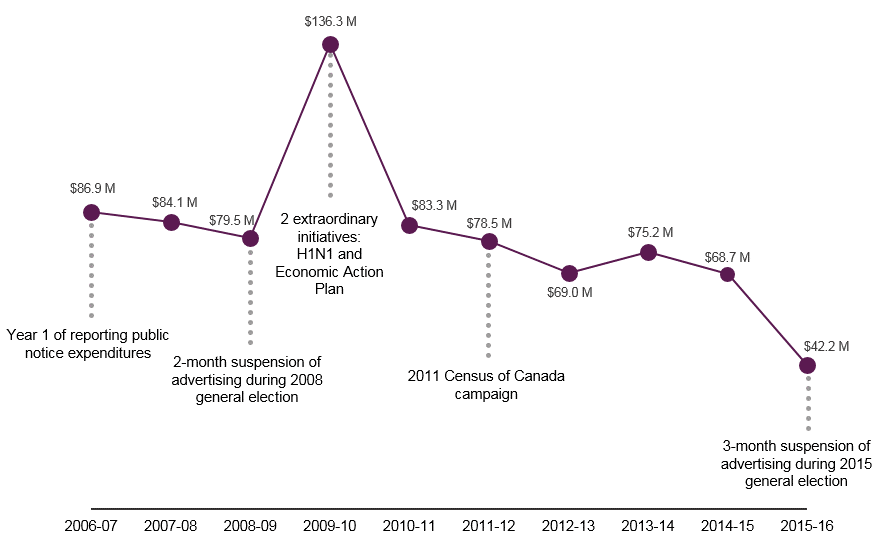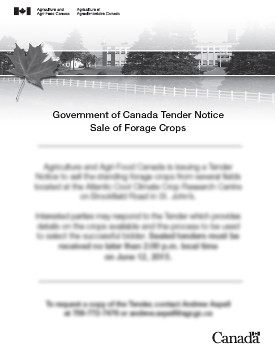Advertising budgets and expenditures—2015 to 2016 Annual report on Government of Canada advertising activities
Activities and expenditures associated with campaign strategic planning, the production of creative materials, media planning and the purchase of media space and time are documented in this report.
How it works
The process for the allocation and management of advertising expenditures was established in 2004. It is designed to ensure that advertising campaigns align to government priorities, comply with government policies, procedures and legislation, and address the information needs of Canadians.
Institutions have the choice to pay for their advertising initiatives from their internal budgets or to obtain funding from the central advertising fund. Generally, the bulk of government advertising campaigns are funded from the latter.
To access the central advertising fund, institutions work with the Privy Council Office to develop advertising proposals that are based on government priorities. The result is an annual advertising plan which is presented to Cabinet for approval. The plan is then submitted to Treasury Board for funding approval and to Parliament for final approval of appropriations to specific institutions.
Funds allocated from the central advertising fund are reported on the Treasury Board of Canada Secretariat website at Government advertising.
| Institutions | Campaigns | Allocations |
|---|---|---|
| Department of Finance Canada | Economic Action Plan | 11 |
| Canadian Heritage | Canada 150 | 7.2 |
| Canada Revenue Agency | Encouraging the Uptake of Tax Measures | 6 |
| Royal Canadian Mounted Police | Royal Canadian Mounted Police Recruitment | 6 |
| Public Works and Government Services Canada | Whole-of-Government Web Buy | 5 |
| Employment and Social Development Canada | Enhanced Universal Child Care Benefit | 4.5 |
| Employment and Social Development Canada | Better Jobs (Skills Initiatives) | 3.5 |
| Public Health Agency of Canada | Vaccination Awareness | 3.5 |
| Veterans Affairs Canada | Remembrance Vignette | 3.5 |
| Citizenship and Immigration Canada | Services to Newcomers (A Fast and Flexible Immigration System) | 3 |
| National Defence | Canadian Armed Forces Recruitment | 2 |
| Health Canada | Preventing the Illicit Use of Marijuana | 1 |
| Grand total | 56.2 | |
Source: Allocations from the Central Advertising Fund
Summary of expenditures
Advertising expenditures fluctuate from year to year depending on government priorities. In 2015 to 2016, expenditures dropped by $26.5 million or 38.6% compared to the previous year, largely because of the mandatory suspension of advertising during the federal election that lasted 94 days. Expenditures fell from $68.7 million in 2014 to 2015 to $42.2 million in 2015 to 2016.
The following chart provides a ten-year perspective of advertising spending by the Government of Canada.
Chart 1: Advertising expenditures: A ten year perspective

Image description of chart 1
This line chart shows the amount of total expenditures for the Government of Canada in millions of dollars over a ten year period with explanations of fluctuations that occurred year over year.
- 2006 to 2007: $86.9 million (Year one of reporting public notices expenditures)
- 2007 to 2008: $84.1 million
- 2008 to 2009: $79.5 million (two-month suspension of advertising during 2008 general election)
- 2009 to 2010: $136.3 million (two extraordinary initiatives: H1N1 and Economic Action Plan)
- 2010 to 2011: $83.3 million
- 2011 to 2012: $78.5 million (2011 Census of Canada campaign)
- 2012 to 2013: $69.0 million
- 2013 to 2014: $75.2 million
- 2014 to 2015: $68.7 million
- 2015 to 2016: $42.2 million (three-month suspension of advertising during 2015 general election)
| Expenditures by type of advertisingFootnote 1 | Total |
|---|---|
| Advertising campaigns | 39.2 |
| Public Notices purchased through the Government of Canada’s Agency of record | 0.2 |
| Public Notices purchased directly by departments | 2.7 |
| Grand total | 42.2 |
A word about public notices
A public notice is a form of advertising. Public notices are typically used for routine business matters, such as regulatory or administrative announcements. Public notices are the only advertising for which institutions have the option to purchase the media space or time directly from media outlets, that is, without involving the Government’s Agency of record (AOR).
Here are some examples of public notices from 2015 to 2016.



- Date modified: